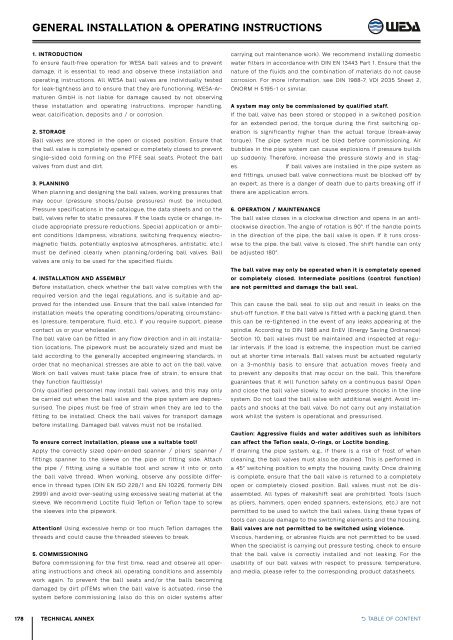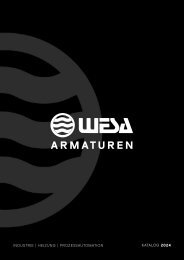Create successful ePaper yourself
Turn your PDF publications into a flip-book with our unique Google optimized e-Paper software.
G<strong>EN</strong>ERAL INSTALLATION & OPERATING INSTRUCTIONS<br />
1. INTRODUCTION<br />
To ensure fault-free operation for <strong>WESA</strong> ball valves and to prevent<br />
damage, it is essential to read and observe these installation and<br />
operating instructions. All <strong>WESA</strong> ball valves are individually tested<br />
for leak-tightness and to ensure that they are functioning. <strong>WESA</strong>-Armaturen<br />
GmbH is not liable for damage caused by not observing<br />
these installation and operating instructions, improper handling,<br />
wear, calcification, deposits and / or corrosion.<br />
2. STORAGE<br />
Ball valves are stored in the open or closed position. Ensure that<br />
the ball valve is completely opened or completely closed to prevent<br />
single-sided cold forming on the PTFE seal seats. Protect the ball<br />
valves from dust and dirt.<br />
3. PLANNING<br />
When planning and designing the ball valves, working pressures that<br />
may occur (pressure shocks/pulse pressures) must be included.<br />
Pressure specifications in the catalogue, the data sheets and on the<br />
ball, valves refer to static pressures. If the loads cycle or change, include<br />
appropriate pressure reductions. Special application or ambient<br />
conditions (dampness, vibrations, switching frequency, electromagnetic<br />
fields, potentially explosive atmospheres, antistatic, etc.)<br />
must be defined clearly when planning/ordering ball valves. Ball<br />
valves are only to be used for the specified fluids.<br />
4. INSTALLATION AND ASSEMBLY<br />
Before installation, check whether the ball valve complies with the<br />
required version and the legal regulations, and is suitable and approved<br />
for the intended use. Ensure that the ball valve intended for<br />
installation meets the operating conditions/operating circumstances<br />
(pressure, temperature, fluid, etc.). If you require support, please<br />
contact us or your wholesaler.<br />
The ball valve can be fitted in any flow direction and in all installation<br />
locations. The pipework must be accurately sized and must be<br />
laid according to the generally accepted engineering standards, in<br />
order that no mechanical stresses are able to act on the ball valve.<br />
Work on ball valves must take place free of strain, to ensure that<br />
they function faultlessly!<br />
Only qualified personnel may install ball valves, and this may only<br />
be carried out when the ball valve and the pipe system are depressurised.<br />
The pipes must be free of strain when they are led to the<br />
fitting to be installed. Check the ball valves for transport damage<br />
before installing. Damaged ball valves must not be installed.<br />
To ensure correct installation, please use a suitable tool!<br />
Apply the correctly sized open-ended spanner / pliers’ spanner /<br />
fittings spanner to the sleeve on the pipe or fitting side. Attach<br />
the pipe / fitting using a suitable tool and screw it into or onto<br />
the ball valve thread. When working, observe any possible difference<br />
in thread types (DIN <strong>EN</strong> ISO 228/1 and <strong>EN</strong> 10226, formerly DIN<br />
2999) and avoid over-sealing using excessive sealing material at the<br />
sleeve. We recommend Loctite fluid Teflon or Teflon tape to screw<br />
the sleeves into the pipework.<br />
Attention! Using excessive hemp or too much Teflon damages the<br />
threads and could cause the threaded sleeves to break.<br />
5. COMMISSIONING<br />
Before commissioning for the first time, read and observe all operating<br />
instructions and check all operating conditions and assembly<br />
work again. To prevent the ball seats and/or the balls becoming<br />
damaged by dirt pITEMs when the ball valve is actuated, rinse the<br />
system before commissioning (also do this on older systems after<br />
carrying out maintenance work). We recommend installing domestic<br />
water filters in accordance with DIN <strong>EN</strong> 13443 Part 1. Ensure that the<br />
nature of the fluids and the combination of materials do not cause<br />
corrosion. For more information, see DIN 1988-7, VDI 2035 Sheet 2,<br />
ÖNORM H 5195-1 or similar.<br />
A system may only be commissioned by qualified staff.<br />
If the ball valve has been stored or stopped in a switched position<br />
for an extended period, the torque during the first switching operation<br />
is significantly higher than the actual torque (break-away<br />
torque). The pipe system must be bled before commissioning. Air<br />
bubbles in the pipe system can cause explosions if pressure builds<br />
up suddenly. Therefore, increase the pressure slowly and in stages.<br />
If ball valves are installed in the pipe system as<br />
end fittings, unused ball valve connections must be blocked off by<br />
an expert, as there is a danger of death due to parts breaking off if<br />
there are application errors.<br />
6. OPERATION / MAINT<strong>EN</strong>ANCE<br />
The ball valve closes in a clockwise direction and opens in an anticlockwise<br />
direction. The angle of rotation is 90°. If the handle points<br />
in the direction of the pipe, the ball valve is open. If it runs crosswise<br />
to the pipe, the ball valve is closed. The shift handle can only<br />
be adjusted 180°.<br />
The ball valve may only be operated when it is completely opened<br />
or completely closed. Intermediate positions (control function)<br />
are not permitted and damage the ball seal.<br />
This can cause the ball seal to slip out and result in leaks on the<br />
shut-off function. If the ball valve is fitted with a packing gland, then<br />
this can be re-tightened in the event of any leaks appearing at the<br />
spindle. According to DIN 1988 and EnEV (Energy Saving Ordinance)<br />
Section 10, ball valves must be maintained and inspected at regular<br />
intervals. If the load is extreme, the inspection must be carried<br />
out at shorter time intervals. Ball valves must be actuated regularly<br />
on a 3-monthly basis to ensure that actuation moves freely and<br />
to prevent any deposits that may occur on the ball. This therefore<br />
guarantees that it will function safely on a continuous basis! Open<br />
and close the ball valve slowly, to avoid pressure shocks in the line<br />
system. Do not load the ball valve with additional weight. Avoid impacts<br />
and shocks at the ball valve. Do not carry out any installation<br />
work whilst the system is operational and pressurised.<br />
Caution: Aggressive fluids and water additives such as inhibitors<br />
can affect the Teflon seals, O-rings, or Loctite bonding.<br />
If draining the pipe system, e.g., if there is a risk of frost of when<br />
cleaning, the ball valves must also be drained. This is performed in<br />
a 45° switching position to empty the housing cavity. Once draining<br />
is complete, ensure that the ball valve is returned to a completely<br />
open or completely closed position. Ball valves must not be disassembled.<br />
All types of makeshift seal are prohibited. Tools (such<br />
as pliers, hammers, open ended spanners, extensions, etc.) are not<br />
permitted to be used to switch the ball valves. Using these types of<br />
tools can cause damage to the switching elements and the housing.<br />
Ball valves are not permitted to be switched using violence.<br />
Viscous, hardening, or abrasive fluids are not permitted to be used.<br />
When the specialist is carrying out pressure testing, check to ensure<br />
that the ball valve is correctly installed and not leaking. For the<br />
usability of our ball valves with respect to pressure, temperature,<br />
and media, please refer to the corresponding product datasheets.<br />
178 TECHNICAL ANNEX<br />
O TABLE OF CONT<strong>EN</strong>T




